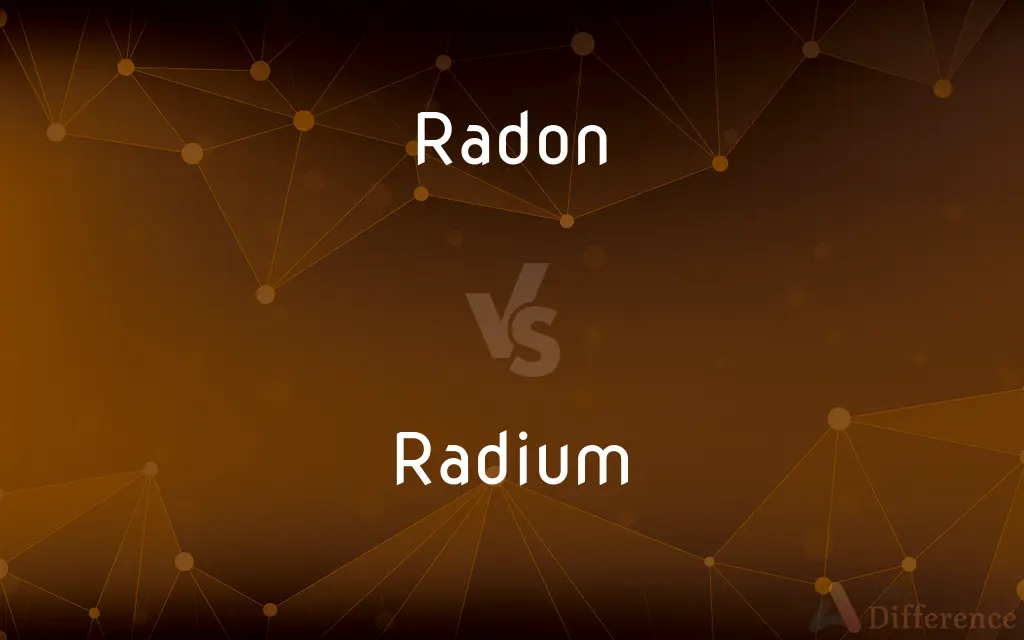Radon vs. Radium — What's the Difference?
Edited by Tayyaba Rehman — By Fiza Rafique — Updated on September 28, 2023
Radon is a radioactive noble gas, while Radium is a radioactive alkaline earth metal. Both result from the decay of uranium and thorium in the earth.

Difference Between Radon and Radium
Table of Contents
ADVERTISEMENT
Key Differences
Both Radon and Radium are elements on the periodic table known for their radioactive properties. They have distinct characteristics and functions.
Radon is a colorless, odorless, tasteless noble gas, and it's the heaviest of the noble gases. Radium, on the other hand, is a silvery-white metal that belongs to the alkaline earth metal group.
A noteworthy aspect of Radon is that it can accumulate in basements or poorly ventilated areas and pose health risks when inhaled. Radium was historically used in glow-in-the-dark paints for watches, airplane instruments, and clock faces because it emits light when combined with phosphorescent materials.
Radon is the result of the decay of radium and is usually found in soil and groundwater. Conversely, Radium is extracted from uranium ore and serves as the precursor to radon.
Despite their risks, both Radon and Radium have had applications in medicine, particularly in cancer treatment. However, the use of radium has declined due to the discovery of safer alternatives.
ADVERTISEMENT
Comparison Chart
Type
Noble gas
Alkaline earth metal
Physical Appearance
Colorless, odorless gas
Silvery-white metal
Radioactive Decay Product
Result of Radium decay
Decays into Radon
Health Risks
Inhalation risk in confined spaces
Prolonged exposure can lead to bone cancer
Uses
Tracer gas, in health risk assessments
Historically in glow-in-the-dark paints
Compare with Definitions
Radon
A radioactive noble gas.
Elevated levels of Radon can be dangerous for residents.
Radium
A radioactive metal.
Marie Curie famously researched Radium and its properties.
Radon
Resulting from Radium decay.
Radon is produced when Radium breaks down in the soil.
Radium
Precursor to Radon gas.
Radium decays to produce Radon over time.
Radon
Known for health risks when inhaled.
Radon testing is essential for homes in high-risk areas.
Radium
Has applications in radiation therapy.
Radium was an early treatment method for certain cancers.
Radon
Has medical applications in therapies.
Radon therapy was once considered for treating tumors.
Radium
Extracted from uranium ores.
The primary source of Radium is the decay chain of uranium.
Radon
Found primarily in soil and groundwater.
Basements can accumulate Radon if not well-ventilated.
Radium
Radium is a chemical element with the symbol Ra and atomic number 88. It is the sixth element in group 2 of the periodic table, also known as the alkaline earth metals.
Radon
Radon is a chemical element with the symbol Rn and atomic number 86. It is a radioactive, colorless, odorless, tasteless noble gas.
Radium
The chemical element of atomic number 88, a rare radioactive metal of the alkaline earth series. It was formerly used as a source of radiation for radiotherapy.
Radon
A colorless, radioactive, inert gaseous element that is formed by the radioactive decay of radium and is used to produce neutrons for research. Its most stable isotope is Rn-222 with a half-life of 3.82 days. A natural source of radiation found in most soils and groundwater, radon poses a serious health threat if inhaled. Atomic number 86; melting point -71°C; boiling point -61.7°C; density of gas 9.73 grams per liter; specific gravity (solid) 4. See Periodic Table.
Radium
A rare, brilliant white, luminescent, highly radioactive metallic element found in very small amounts in uranium ores, having more than 40 isotopes and isomers with mass numbers between 201 and 234, of which Ra-226 with a half-life of 1,600 years is the most common. It is used as a neutron source for some research purposes and was formerly widely used in cancer radiotherapy and as a constituent of luminescent paints. Atomic number 88; melting point 696°C; boiling point 1,737°C; specific gravity 5; valence 2. See Periodic Table.
Radon
The chemical element (symbol Rn, formerly Ro) with atomic number 86. It is an odorless, colorless, chemically inert but radioactive noble gas.
Radium
The chemical element (symbol Ra) with an atomic number of 88. It is a soft, shiny and silvery radioactive alkaline earth metal.
Radon
Radon-222 (Rn), the most stable isotope of this element, .
Radium
A type of cloth woven from silk or synthetic yarn, often with a shiny appearance.
Radon
An intensely radioactive gaseous element produced by the radioactive decay of radium-226, which is the main isotope of radium found in pitchblende. Chemically it is an inert noble gas. Its atomic symbol is Rn. It has an atomic number of 86. The radon isotope produced by decay of radium has an atomic weight of 222.017, and this isotope decays by alpha emission with a half-life of 3.82 days. Numerous other isotopes have been observed, all radioactive and all having half-lives shorter than that of radon-222. Radon was discovered by M. and Mme. Curie, of Paris, in their studies of the radioactive substances in pitchblende. Radon was originally called radium emanation or exradio.
Radium
To treat (a tumour, etc.) with radium.
Radon
A radioactive gaseous element formed by the disintegration of radium; the heaviest of the inert gasses; occurs naturally (especially in areas over granite) and is considered a hazard to health
Radium
An intensely radioactive metallic element found (combined) in minute quantities in pitchblende, and various other uranium minerals. Symbol, Ra; atomic weight, 226.4. Radium was discovered by M. and Mme. Curie, of Paris, who in 1902 separated compounds of it by a tedious process from pitchblende. Its compounds color flames carmine and give a characteristic spectrum. It is divalent, resembling barium chemically. The main isotope of radium found in pitchblende, radium-226, has a half-life of 1620 years, decaying first by alpha emission to radon.
Radium
An intensely radioactive metallic element that occurs in minute amounts in uranium ores
Radium
Used historically in luminescent paints.
Watches used Radium paint to glow in the dark.
Common Curiosities
Why was Radium used in watches?
It was used for its glow-in-the-dark properties.
Are both Radon and Radium dangerous?
Yes, prolonged exposure can pose health risks.
How can one detect Radon in homes?
Through Radon testing kits and professionals.
Is Radium still used in medical treatments?
Its use has declined in favor of safer alternatives.
Are there guidelines for safe Radon levels?
Yes, agencies like the EPA provide guidelines.
Can Radon be entirely eliminated from homes?
Not entirely, but levels can be reduced to safe limits.
How is Radium extracted?
From uranium ore through a series of chemical reactions.
Where is Radon typically found?
In soil, groundwater, and poorly ventilated areas.
Do all soils produce Radon?
Most soils contain trace amounts of radium, producing Radon.
Was Radium always known to be harmful?
Its dangers were discovered after initial widespread use.
Can Radium poisoning be treated?
Once ingested, the damage is irreversible but further exposure can be limited.
How does Radon enter buildings?
Through cracks, openings, and poorly ventilated areas.
What made Radium popular in the past?
Its glow-in-the-dark property and novel applications.
Share Your Discovery

Previous Comparison
Lice vs. Rice
Next Comparison
Heartfelt vs. HeartfulAuthor Spotlight
Written by
Fiza RafiqueFiza Rafique is a skilled content writer at AskDifference.com, where she meticulously refines and enhances written pieces. Drawing from her vast editorial expertise, Fiza ensures clarity, accuracy, and precision in every article. Passionate about language, she continually seeks to elevate the quality of content for readers worldwide.
Edited by
Tayyaba RehmanTayyaba Rehman is a distinguished writer, currently serving as a primary contributor to askdifference.com. As a researcher in semantics and etymology, Tayyaba's passion for the complexity of languages and their distinctions has found a perfect home on the platform. Tayyaba delves into the intricacies of language, distinguishing between commonly confused words and phrases, thereby providing clarity for readers worldwide.















































